Did you know that some seeds are much easier to direct sow than they are to start indoors? Yep, it’s true! So in this post, I put together a list of the easiest seeds to direct sow to get you started…
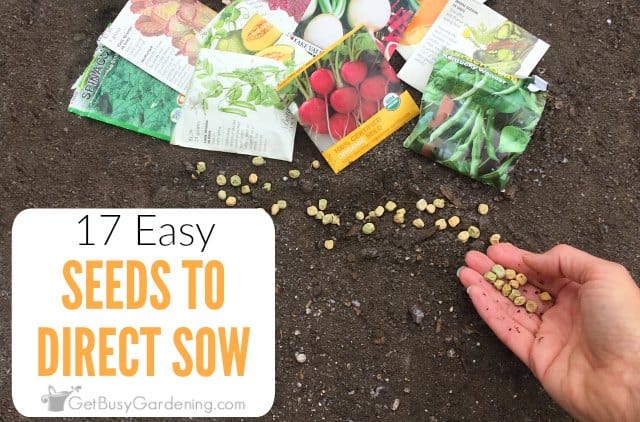
When I was a newbie gardener, I thought I needed to start all of my seeds indoors. Although I was pretty successful growing lots of different types of seeds inside, I had many failures too.
After a few years of trial-and-error, I began to experiment with starting seeds both indoors and direct sowing (i.e.: planting) them right in my garden.
I literally tossed my leftover seeds into the garden in the spring just to see what would sprout.
It turns out that some seeds will grow better when planted directly into the garden. And direct planting some types of seeds is SO MUCH easier than starting them indoors.
So I decided to put together this list of the easiest seeds to direct sow in your garden to help you get going…

17 Easiest Seeds To Direct Sow
Below I have broken my list of easy seeds to direct sow down into two sections. The first one is for vegetables and herbs. Then below that, the second section is my favorite flowers that are easiest to direct sow.
Vegetables & Herbs
Here you will find some of the best vegetable and herb seeds to plant directly in your garden. These seeds either have a short enough growing season, or they are frost tolerant and can be sown directly into the garden as soon as the ground thaws in early spring.
1. Dill
Fresh dill is not only great in recipes, it’s also a host plant for the black swallowtail butterfly (so be sure to plant extra for them too!).
Sprinkle the seeds over the garden in late winter or very early spring. Try growing these dill seeds in your garden this year.
2. Pumpkin
Pumpkin seeds are super easy to grow. They do best when planted in the garden because transplanting the seedlings can stunt their growth.
Sow the seeds 2 weeks after your last frost once the soil has warmed up in the spring. Sugar Pie is perfect for baking, and Jack-O’-Lantern is the type to grow for large pumpkins.
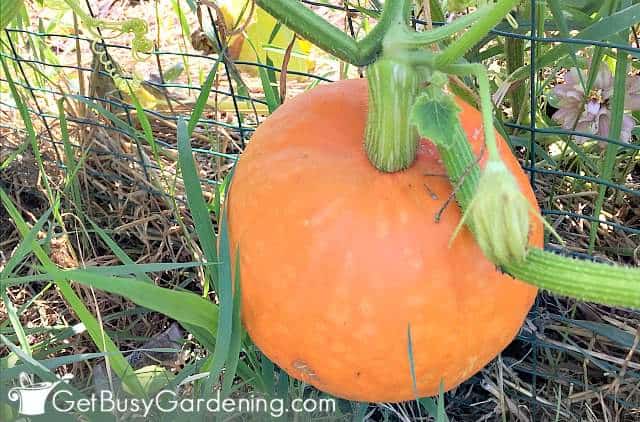
3. Radishes
These cold hardy root crops will survive frost, so the seeds can be planted very early. Cherry Belle are my go-to, but white and Watermelon are both fun to grow too.
Plant the seeds as soon as the soil can be worked in early spring. Learn how to grow radishes from seed here.
4. Lettuce
Lettuce is another wonderful cold season crop that can be direct sown very early in the spring.
A few of my favorite kinds to grow are a mesclun mix, Valentine and Romaine Rouge. Sow them 2-4 weeks before average last frost. Learn how to grow lettuce from seed here.
5. Cilantro
Cilantro also grows best in cool weather, and will go to seed as soon as it warms up in early summer. So be sure to plant them at least 2 weeks before your last spring frost date.
Here are some good cilantro seeds to get you started. You can learn exactly how to grow it here.
6. Squash
Squash seedlings don’t like to being transplanted, so that’s why they should be direct sown.
Plant the seeds once the soil is warm in the spring (about 2-4 weeks after your last frost). Zucchini, Butternut and Delicata are my favorites.
7. Spinach
Spinach is another cool weather vegetable that will bolt (go to seed) as soon as it gets warm in the summer. Here’s a good, longer standing variety you can try.
Direct sow seeds outdoors as soon as the ground can be worked first thing in early spring. Learn how to grow spinach from seed here.
8. Beans
A great seed for beginners to grow, beans are best to direct sow rather than starting them indoors.
Plant the seeds directly into your garden after all danger of frost in late spring. Kentucky Wonder and purple pole beans are two good vining types, otherwise try Blue Lake bush beans.
9. Cucumber
Cucumbers don’t like to be transplanted, so it’s best to direct sow the seeds. Wait until the soil has warmed a few weeks after frost in the spring, and then plant the seeds in a full sun location.
My favs are Marketmore and picklers. Get step-by-step instructions for growing cucumber seeds here.
10. Peas
Peas are frost hardy, so you can plant them early. Sow the seeds directly into your garden 4-6 weeks before your spring planting date, once the soil is workable. I love to grow snow peas and sugar snap peas.
11. Carrot
You should always direct sow carrot seeds because any type of root disturbance can lead to deformities. A few good varieties that I grow are your basic garden carrot, or try a smaller variety for heavier soil.
Plant the seeds 3-6 weeks before the last spring frost, once the soil is workable. Learn how to grow carrots from seed here.
12. Beets
Beets are not only delicious, they add wonderful color to the garden. Sow outside 2-4 weeks before average last frost for an early summer crop.
Soak the seeds 8-24 hours before planting for better germination. Dark red beets are gorgeous, and so is this colorful mix!
Flowers
If you’re interested in direct sowing flower seeds, then this section is for you! Some of these seeds can simply be sprinkled over the garden in the fall or early spring, while others will need a little more help from you to get planted.
13. Morning Glory
Morning glories won’t tolerate the cold, and direct sowing the seeds too early could stunt their growth.
Wait until the soil has warmed before planting the seeds in late spring (a few weeks after last frost). Soak the seeds for 12-24 hours before planting for faster germination. Here’s a great morning glory seed mix for you to try.
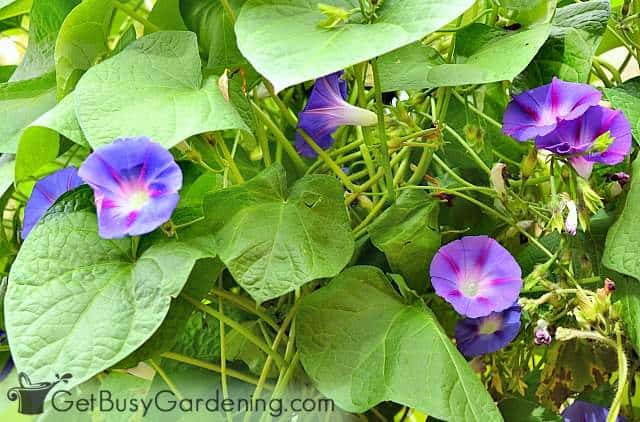
14. Calendula
Calendula are easy to grow by direct sowing the seeds. Either sprinkle them around the garden in the fall, or plant them as soon as the ground can be worked in early spring. Calendula Zeolights and Resina are both lovely varieties to grow.
15. Snapdragon
You probably didn’t know this, but snapdragon flowers are frost hardy.
Sprinkle the seeds over your garden in the fall, or as soon as the soil can be worked in very early spring. I like to plant a snapdragon color mix, but I also love Night and Day.
16. Sunflower
After years of trying to get them to grow indoors, I discovered that sunflowers are WAY easier to direct sow.
Plant them in full sun 1-2 weeks after your average last spring frost date. This red mix is gorgeous, and you can never go wong with Lemon Queen.
17. Petunia
Petunias will also tolerate the cold, and are easy to direct sow. Simply sprinkle the seeds over the garden, and gently press them into the soil in fall or early spring.
Purple Wave is a fantastic variety, but you should also try Frappe Rose and Red Velour.
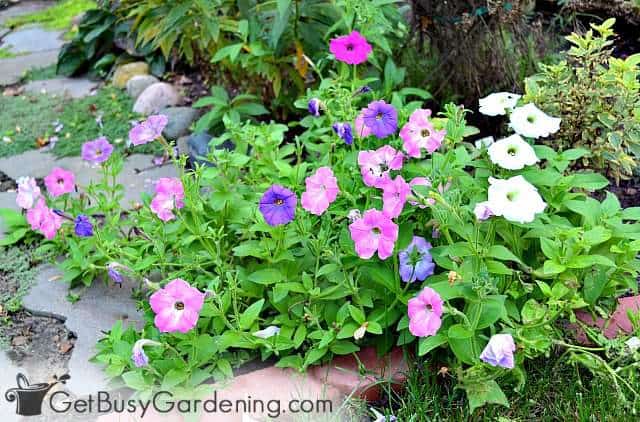
There are tons of different types of seeds than can be planted directly in the garden. But if you’re a newbie, it’s best to start with the easiest seeds to direct sow. Then once you gain some confidence, you can move on to experimenting with other types of seeds next.
If you’re tired of struggling, and want to learn how to grow any plant you want from seed, then enroll in my online Seed Starting Course. It’s a wonderful, fun, self-paced course that will teach you everything you need to know to easily grow your own seedlings. Enroll and get started today!
Or, if you just need a refresher, then my Starting Seeds Indoors eBook is for you! It’s a quick-start guide that will get you planting seeds in no time.
More Posts About Growing Seeds
- 23 Easiest Vegetables To Grow from Seed
- 13 Easy Annual Flowers To Grow From Seed
- 17 Easiest Seeds To Start Indoors
Leave a comment below and tell me your top choices for the easiest seeds to direct sow.
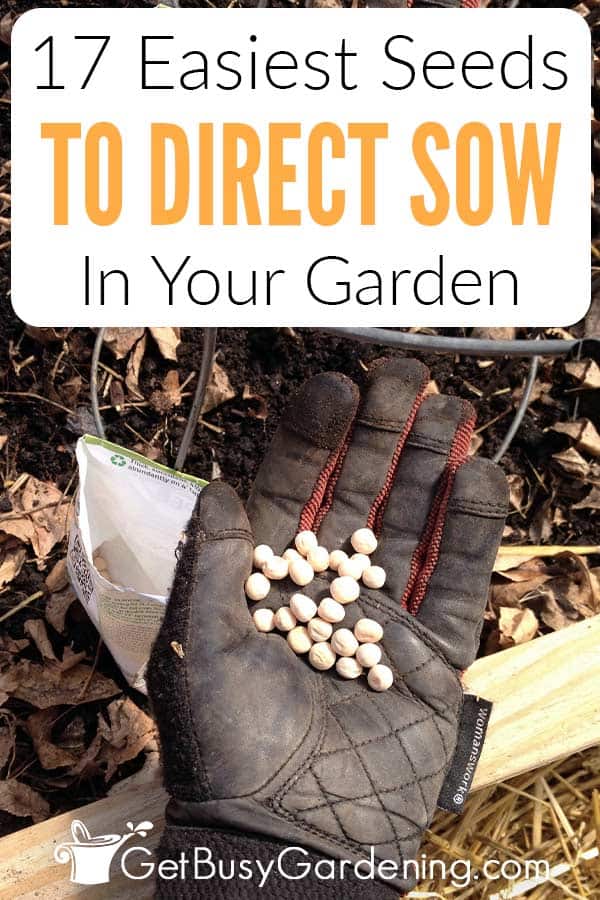
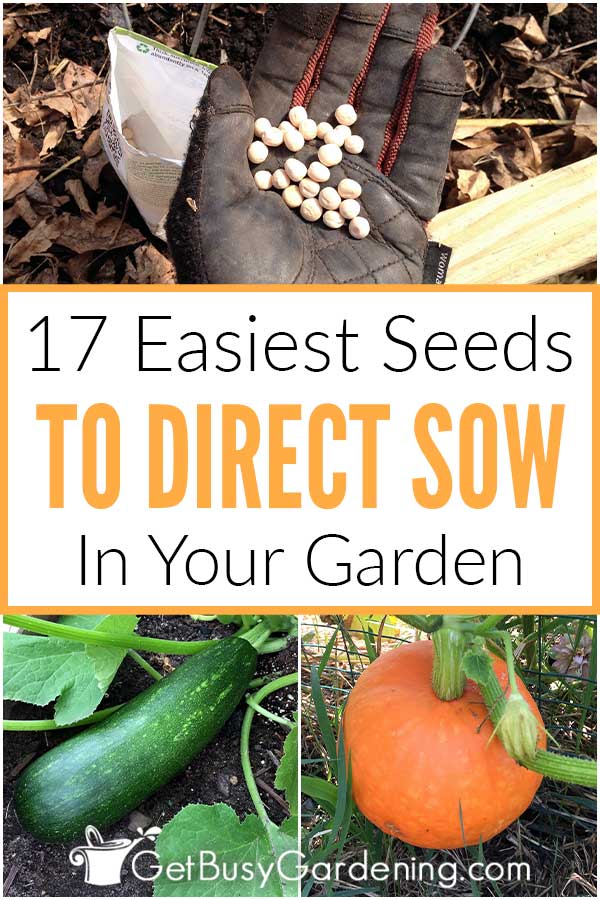
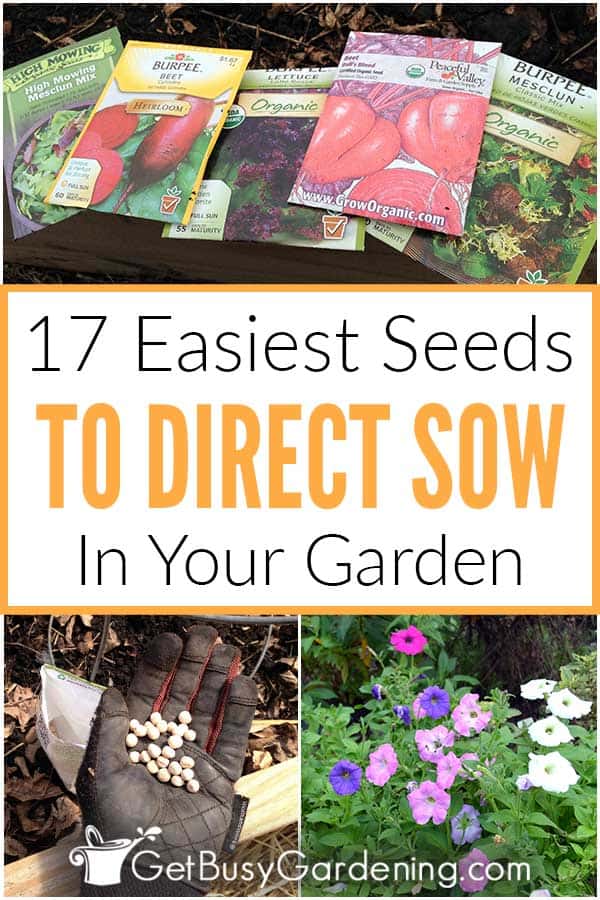
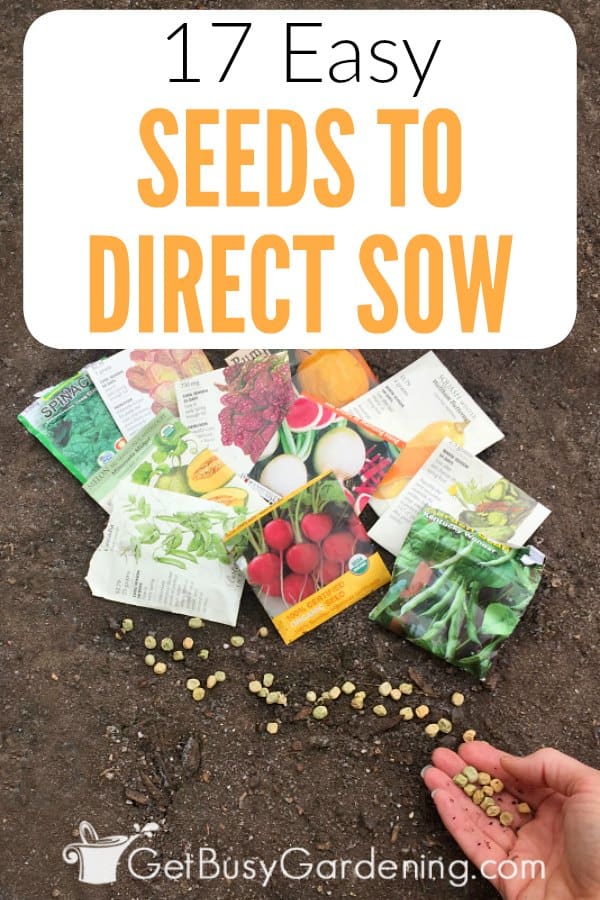

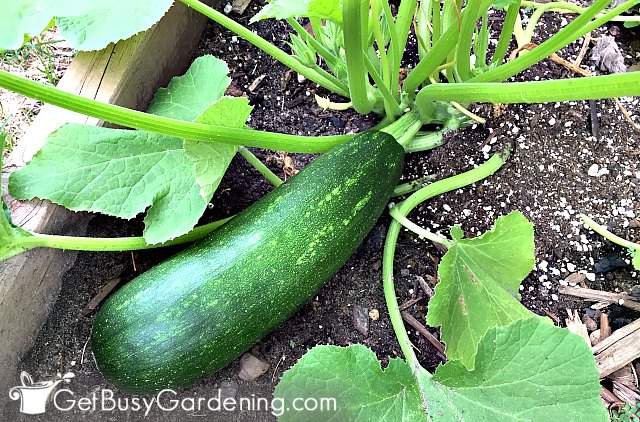
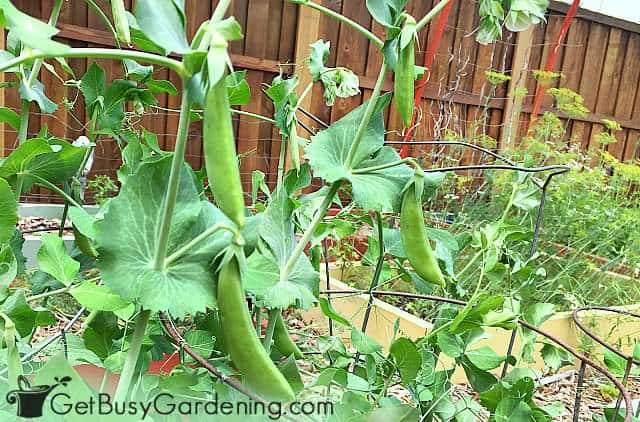


Crystl Parcher says
This is my first time sowing seeds directly, but I can’t find anywhere that tells me what to do after I sow the seeds. Do I cover the soil with mulch? Will the plants be able to come through the mulch if I use pine straw?
Amy Andrychowicz says
I don’t recommend covering your direct sown seeds with mulch. That would probably keep them from growing. It’s best to wait until the seeds start growing, then cover the surrounding soil with mulch.
Emily says
This article was really helpful. I am planning to start my first garden and am feeling overwhelmed! I live in California and am planning on planting seeds directly into existing garden beds but the soil has been growing weeds since we moved in two years ago. What should I add to the soil prior to planting my vegetable seeds? Any help would be appreciated!
Amy Andrychowicz says
Thanks, I’m glad you like the list! You’ll definitely need to get all of those weeds under control before you can plant seeds into your garden. Depending on how overgrown it is, there are a few ways you can prepare it for planting. Here are a few posts with detailed steps for how to prepare your garden for planting… How to Prepare A Garden Bed For Planting Vegetables and How To Make A No Dig Garden Make it easy on yourself, and choose the best method for your situation. Hopefully reading those posts will help take away your overwhelm!
Doris says
Hi there,
I direct sow kale and fennel too, whenever i plant fennel from seedlings they bolt in the sommerheat, they worked best for me sown in June for a fall harvest.
Pepper and eggplants will grow much better if they get a plastictent in spring to keep them warm and humid, i leave it over the plants till the plants are getting too big In July. Last year i had eggplants before tomatoes.
I live in zone 4
Doris
Amy Andrychowicz says
Awesome, thanks for sharing your great tips and experience! It’s fun to experiment with directing sowing different types of seeds to see which ones work best in your growing zone. 🙂
Ed Kniska says
My wife and I have been planting vegetable and flower gardens for many years, and have been trying doing some from seeds the last couple of years.
Since we live in New England, we do not have a long growing season.
I have tried for the last 2 years to grow red peppers and egg plant from seeds starting end of March to beginning of April with not much success and eventually purchasing the plants.If the seedlings develop, they tend to be very small compared to the plants that are for sale in mid May. Should I be starting them earlier so they have at least 12 weeks to develop instead of 8 weeks indoors?
Amy Andrychowicz says
I can totally relate! Here in Minnesota, we also have a short growing season. We can’t direct sow peppers or eggplants, we have to start those indoors well before they can be planted into the garden. I like to start my peppers and eggplants 2-3 months before I can plant them into the garden. I’ve had great success with starting them super early, and sometimes they are even bigger than the ones that are sold at the stores in the spring. Here’s a post I wrote about starting peppers from seed (and the same advice applies for growing eggplant seeds)… How To Grow Peppers From Seed